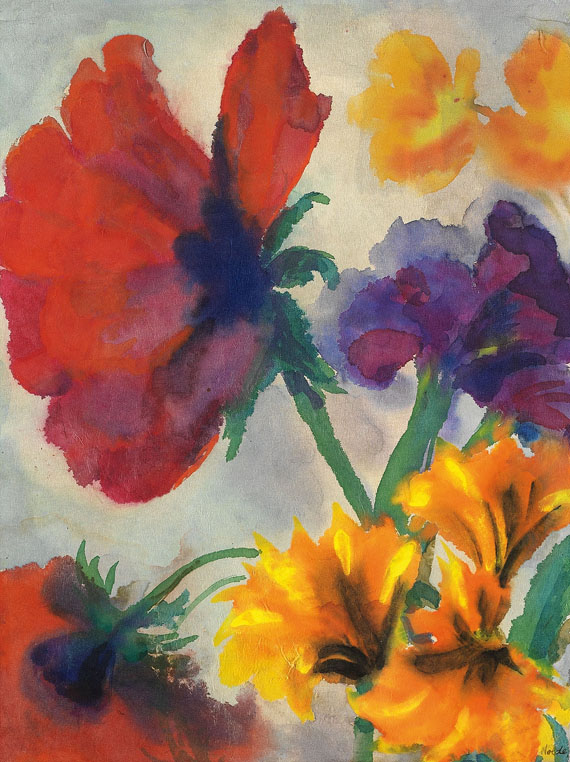Emil Nolde - Mohn, gelbe und blaue Blüten, 1935
Emil Nolde - Mohn, gelbe und blaue Blüten, 1935
EMIL NOLDE
Mohn, gelbe und blaue Blüten, 1935.
Aquarell
Poppies, yellow and blue flowers . Around 1935.
Watercolor.
Signed lower right. On Japan 45.7 x 34.2 cm (17.9 x 13.4 in), the full sheet.
With a photo expertise from Dr. Manfred Reuther, Seebüll Ada and Emil Nolde Foundation, dated October 9, 2007. The work is registered there
PROVENANCE: Private collection Southern Germany (acquired from Dr. Rudolf Probst, Mannheim, 1940).
Emil Hansen was born on August 7, 1867 in the German-Danish border region. He later adopted the name of his hometown Nolde as his stage name. With the decision to become a painter, Nolde finally goes to Munich, but the academy under Franz von Stuck rejects him. This was followed by studies at Adolf Hölzel's private painting school in Dachau and, from 1899, at the Académie Julian in Paris. In 1900 he rents a studio in Copenhagen and in 1903 moves to the island of Alsen. By engaging with Neo-Impressionism, from 1905 onwards, Nolde came up with an independent style in which color played an essential role; color-intensive, luminous flower pictures are created. In 1906 Nolde met the "Brücke" painters, whose group he temporarily joined. In a series of portrait studies, he began to turn to watercolors. After a controversy with Max Liebermann, Nolde was expelled from the "Berliner Sezession" and founded the "Neue Sezession" in 1910 with other rejected artists, in whose exhibitions he participated until 1912. From an expedition to New Guinea in 1913 he brought with him a wealth of study material, which he processed in numerous works until 1915. From 1916 he spent the summer on the island of Föhr and settled in Seebüll in 1928. The garden created there becomes an inexhaustible source of inspiration for his painting. From an expedition to New Guinea in 1913, he brought back a wealth of study material, which he processed in numerous works until 1915. From 1916 he spent the summer on the island of Föhr and settled in Seebüll in 1928. The garden created there becomes an inexhaustible source of inspiration for his painting. From an expedition to New Guinea in 1913, he brought back a wealth of study material, which he processed in numerous works until 1915. From 1916 he spent the summer on the island of Föhr and settled in Seebüll in 1928. The garden created there becomes an inexhaustible source of inspiration for his painting.
For Emil Nolde, color is the essential element, the essential means of expression in his art. "Yellow can paint happiness and also pain. There is fire red, blood red and rose red. There is silver blue, sky blue and storm blue. Each color has its soul within it, making me happy or repulsive and stimulating" (Emil Nolde, quoted from: Martin Urban , Emil Nolde - Landscapes. Watercolors and Drawings, Cologne 2002, p. 16). The present work also proves this passion of the painter. The close-up rendered petals pulsate in their different nuances from matt violet to bright yellow, the colors unfold against the neutral background that mysterious luminosity that only Nolde can achieve.
From 1938 Nolde painted his "Unpainted Pictures", numerous small watercolors, which he took up again in oil paintings after 1945. In the last years of his life, he created mainly watercolors with flower and landscape motifs from the vicinity of his house in Seebüll, where the artist died on April 13, 1956. [NB]
Condition: In good condition, colors still fresh. Verso of the upper corners of the sheet with remains of an old paper tape mounting, there with minimal crease marks on the recto.

Comments
Post a Comment